Physical Address
304 North Cardinal St.
Dorchester Center, MA 02124
Breast cancer is the most frequently diagnosed cancer in women in the United States, accounting for an estimated 268,670 new cases of invasive breast carcinoma, 63,960 new cases of in situ carcinoma, and 41,400 deaths in 2018.
In the United States, the age-specific incidence of breast cancer increases with age, to a lifetime risk of breast cancer of 1 in 8; by age 40 years, approximately 1 in 203 women will have been diagnosed with breast cancer; at 60 years of age, the figure is 1 in 28 women.
Incidence rates have been rising about 1% per year; mortality rates stayed relatively constant until recently, when annual decreases were seen.
A sharp decline in the incidence of breast cancer in the early 2000s followed a decrease in the use of postmenopausal hormone replacement therapy; the incidence rate has since remained stable.
Age, family history, and both endogenous and exogenous ovarian hormone exposure have an important effect on risk and have been incorporated into models that predict individual risk of breast cancer; diet, alcohol use, and other factors play a smaller role.
African Americans with breast cancer are diagnosed at more advanced stages and have worse outcomes, including survival.
Inherited mutations in BRCA1, BRCA2, PTEN, TP53, STK11, ATM, CHEK2, PALB2, and other genes can increase the risk of breast cancer; individuals with a personal or family history of hereditary breast cancer should be referred for genetic evaluation.
The expression of nuclear estrogen and progesterone receptors plays an important role in the differentiation and growth of normal breast epithelium and the response of breast cancer cells to hormonal therapeutics.
ERBB2 (human epidermal growth factor receptor 2 [HER2]) is a growth-signaling molecule on the surface of normal breast cells that is overexpressed in approximately 20% of breast cancer tumors, contributing to growth autonomy and genomic instability.
Molecular analyses have defined at least four biologic subtypes of breast cancer, including basal type, two luminal types (luminal A and luminal B), and the HER2-enriched type.
BRCA1 and BRCA2 are tumor suppressor genes that play a critical role in homologous recombination repair (HRR) of DNA damage; inherited mutations in these and other HRR genes are associated with an increased risk of breast cancer.
Regardless of the criteria used by an individual physician and patient to define high risk, four possible actions may be taken, some of which can be used simultaneously: (1) enhanced surveillance, (2) behavioral modification, (3) chemopreventive strategies, and (4) prophylactic mastectomy or oophorectomy.
Although exact guideline recommendations for mammography screening remain controversial and are debated, all guidelines agree that most lives are saved with screening starting at age 40. The 2015 American Cancer Society (ACS) guidelines recommend a yearly mammogram starting at age 45, with the option to transition to biennial screening at age 55, and the option to begin screening between ages 40 and 44. Similarly, the American College of Radiology recommends yearly mammography starting at age 40. The 2016 US Preventive Services Task Force (USPSTF) breast cancer screening guideline recommends biennial screening mammography for women ages 50 to 74 years and an individualized approach for women ages 40 to 49 years. The ACS also recommends that breast magnetic resonance imaging (MRI) be used in addition to mammographic screening in women with a lifetime risk of breast cancer greater than 20%.
Microcalcification and soft tissue density are the major indications for biopsy after mammographic screening; the mammographic abnormality with the highest rate of malignancy is a mass with associated calcification.
For patients with breast symptoms or palpable abnormalities, mammography, in conjunction with other imaging modalities such as ultrasonography and breast MRI as indicated, is used to characterize the suspicious area, evaluate the remainder of the breast for occult lesions, and assess the contralateral breast.
Malignant breast masses classically are nontender and firm, with irregular borders.
Diagnostic methods include needle-core biopsy with ultrasound or stereotactic guidance, fine-needle aspiration cytology, and excisional biopsy, with or without wire localization.
Lobular carcinoma in situ (LCIS) is a nonpalpable lesion that usually is discovered with another indicator for biopsy; it is an indicator of risk of subsequent invasive breast cancer. The rare pleomorphic variant of LCIS seems to have a more aggressive behavior and is considered more as a precursor of invasive lobular cancer rather than a marker of breast cancer risk.
Management of LCIS has shifted toward observation after biopsy rather than mastectomy; increasing evidence shows that tamoxifen should be considered as a preventive approach.
Unlike LCIS, ductal carcinoma in situ (DCIS) is almost always first identified with mammography; it accounts for most of the increasing number of carcinoma in situ lesions diagnosed.
DCIS is more likely to be localized to one area of the breast; therefore most patients are candidates for breast conservation. Tamoxifen or, in postmenopausal women, aromatase inhibitors should also be considered after lumpectomy and radiation therapy to reduce the risk of another ipsilateral or a new contralateral breast cancer event, which can be invasive or noninvasive.
Patients should undergo a complete history and physical examination.
Bilateral mammography is indicated for all patients, and other breast imaging (ultrasound and MRI) should be used as needed for each individual patient; advanced imaging studies are recommended only to evaluate specific signs or symptoms or in patients with locally advanced disease.
Prognostic factors include pathologic tumor size, hormone receptor expression, HER2 status, axillary nodal status, histologic subtype, and tumor grade.
Multiple gene expression profiling assays have been developed as prognostic tests.
The 21-gene recurrence score assay predicts benefit from systemic chemotherapy in addition to endocrine therapy in node-negative, hormone receptor–positive breast cancer, and is undergoing evaluation for use in node-positive disease.
The seventh edition of the American Joint Committee on Cancer TNM staging system takes into account the increasing use of advanced imaging and pathology techniques, such as sentinel node biopsy and immunochemistry; it also considers the number of involved nodes as a strong prognostic factor.
Sentinel lymph node mapping is now the standard of care for many women with early breast cancer because it is more accurate and less morbid than axillary dissection.
For patients with stages I and II disease, breast conservation (lumpectomy followed by radiation therapy) and simple mastectomy are the major therapeutic options; for most patients, breast conservation is the preferred approach.
Adjuvant therapy with cytotoxic drugs, endocrine therapy, and/or anti-HER2 therapy is recommended depending on stage of disease and pathologic characteristics.
For patients with locally advanced disease, multimodality therapy is recommended; the sequence of systemic therapy, surgery, and radiation therapy depends largely on the operability of the primary disease.
For women with inoperable or inflammatory breast cancer, preoperative chemotherapy is recommended, followed by surgery, radiation therapy, and endocrine therapy, if appropriate. Patients with HER2-positive disease should also receive anti-HER2–targeted therapy. Preoperative endocrine therapy for patients with hormone receptor–positive disease may also be a reasonable option.
HER2 is a strong predictive marker, and accurate determination of HER2 status identifies patients with T1bN0 tumors and above who should be considered candidates for adjuvant therapy with a trastuzumab-based regimen.
Expression of estrogen receptor and/or progesterone receptor is a predictive marker for response to endocrine therapy.
The results of the serial meta-analyses performed by the Early Breast Cancer Trialists’ Collaborative Group (EBCTCG) show that the survival benefits of adjuvant chemotherapy and endocrine therapy persist after 15 years of follow-up.
Challenges that require resolution include identification of biologic parameters that more precisely predict the natural history of disease and the response to systemic therapy; more effective treatments are needed.
Local recurrence is an indicator of systemic relapse in most cases; an exception may be local relapse in a breast that has undergone conservation therapy.
Surgical removal alone may be sufficient in some cases, but it often is combined with locoregional radiotherapy and/or systemic therapy.
Although a small percentage of patients with metastatic breast cancer achieve long-term disease-free survival, this stage of disease is generally not curable, and therapy is largely palliative.
A wide range of systemic, local, and supportive therapies are available for the palliation of metastatic breast cancer. Primary breast surgery may be indicated in selected patients with stage IV disease.
The selection of endocrine, cytotoxic, or biologic therapy usually is based on disease-free interval, receptor status, HER2 status, presence or absence of visceral involvement, performance status, age, and previous exposure to systemic therapy.
The treatment approach for metastatic breast cancer generally involves sequential therapies, each continued until disease progression or unacceptable toxicity.
Patients with hormone receptor–positive, HER2-nonamplified metastatic breast cancer should be considered initially for endocrine-based therapy, with systemic chemotherapy reserved for patients who are significantly symptomatic or have compromised organ function.
Anti-HER2 agents, such as trastuzumab, lapatinib, pertuzumab, and ado-trastuzumab emtansine have changed the natural history of patients with HER2-positive metastatic breast cancer.
Treatment with bisphosphonates or denosumab is indicated to minimize bone complications in patients with bone metastases.
Worldwide, breast cancer is the most common type of cancer among women. In the United States, approximately 268,670 new cases of invasive breast carcinoma, 63,960 new cases of in situ carcinoma, and 41,400 deaths were expected in 2018. In women, breast cancer accounts for 29% of new cases of cancer and 14% of cancer deaths, second only to lung cancer as a cause of cancer-specific death. Approximately 1% of breast cancers occur in males, and 90% of these are estrogen receptor (ER) positive. Incidence rates of breast cancer decreased by 2% per year from 1999 to 2005, and have remained relatively stable since then ( Fig. 88.1 ). The decline appears to be partly the result of a decrease in the use of postmenopausal hormone replacement therapy (HRT). Although incidence rates (all races combined) are substantially higher for women older than age 50 years, approximately 23% of breast cancers are diagnosed in women younger than age 45 years ( Table 88.1 ).
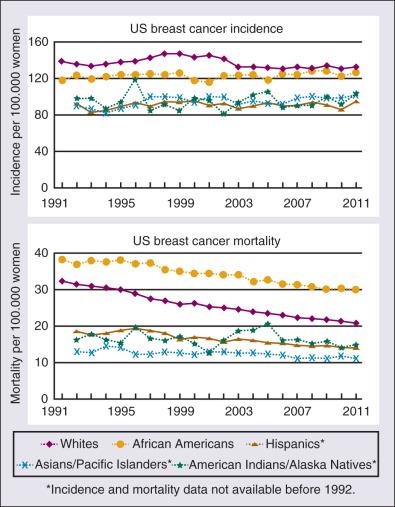
| Age Range (years) | Breast Cancer Risk |
|---|---|
| 30–40 | 1 : 227 |
| 40–50 | 1 : 68 |
| 50–60 | 1 : 44 |
| 60–70 | 1 : 29 |
| Lifetime (to age 110 years) | 1 : 8 |
Between 2008 and 2012, breast cancer was the most common cancer diagnosed in women in the United States (overall incidence 123.1 per 100,000 women), followed by lung cancer (overall incidence 54.1 per 100,000 women). However, the leading cause of cancer death was lung cancer (37.8 per 100,000 women), followed by breast cancer (21.9 per 100,000 women). Mortality rates from breast cancer have been decreasing over time in the United States (see Fig. 88.1 ). Around the world, there are large variations in incidence, mortality, and survival, which may be a result of several underlying complex factors, including age, ethnicity, diet, and lifestyles, including reproductive issues. Breast cancer is increasing in less-developed countries, likely related to changes in lifestyle factors. Most of our knowledge regarding specific risk factors has been derived from large observational studies in developed countries, such as the Nurses’ Health Study (NHS) and NHS II in the United States, and the Million Women Study in the United Kingdom. Some of these risk factors are briefly summarized in the following sections.
The best-established dietary factor associated with increased risk for breast cancer is higher consumption of alcohol. Initial studies correlated higher fat intake and decreased intake of fruit and vegetables with an increased risk for breast cancer, but more recent prospective studies have failed to confirm those observations. One randomized study (Women's Healthy Eating and Living [WHEL] Study) in breast cancer patients who consumed a low-fat and high–fruit-and-vegetable diet did not demonstrate a decreased risk of breast cancer recurrence. However, a second randomized study (Women's Intervention Nutrition Study [WINS]) demonstrated a lower risk of recurrence with a decreased intake of dietary fat associated with modest weight loss in breast cancer survivors.
Dietary phytoestrogens, such as those found in soybeans, have a chemical structure that is similar to that of 17β-estradiol and can bind to the ER to compete with estrogens. Their consumption may have a weak protective effect against breast cancer. More recent studies have suggested an inverse association of soy intake and breast cancer in Asian but not non-Asian populations. Although there is significant interest in the association of vitamin D intake and breast cancer risk, there are insufficient data to draw conclusions regarding potential benefit at this time; some data suggest that there may be an association in postmenopausal women.
The accumulated knowledge about radiation-related breast cancer risk in women derives mainly from epidemiologic studies of patients exposed to diagnostic or therapeutic radiation and of Japanese atomic bomb survivors. Therapeutic radiation, particularly extended-field radiation therapy for Hodgkin lymphoma, has been associated with an increased risk of breast cancer. The age of exposure is important, with the highest breast cancer risk seen in women undergoing mantle irradiation around puberty, and is minimal for women exposed after menopause.
The NHS originally was designed to determine whether oral contraceptive use was associated with an increase in breast cancer. Analysis of data from that study and many additional studies has confirmed that current users of exogenous hormones have a slightly increased risk of developing breast cancer, although this risk resolves within 5 years of discontinuation of therapy. In addition, use of exogenous hormones is associated with a decreased risk of colon and ovarian cancer; there is no increase in overall cancer mortality associated with their use. The Women's Health Initiative (WHI) randomized study of HRT in postmenopausal women demonstrated an increased risk of invasive breast cancer with the combination of estrogen plus progesterone therapy, but not with estrogen alone. Other studies have also demonstrated that breast cancer risk is affected by type of HRT and time of initiation of HRT, with an increased risk seen with therapy started soon after menopause. After initial publication of the WHI results and widespread discontinuation of HRT, age-adjusted incidences of invasive breast cancer decreased in the United States between 2002 and 2003 by 7%, primarily in ER-positive tumors in women 50 years of age or older.
Breast cancer risk consistently has been correlated with an earlier age of menarche, later age of menopause, nulliparity, and late age of first birth, all of which determine the cumulative number of ovarian cycles. This finding is consistent with the correlation between estrogen levels and breast cancer risk. In postmenopausal women, an increased risk of breast cancer has been demonstrated in those with estradiol levels in the highest quartile.
There is a clear association between obesity and breast cancer risk. Women with a body mass index (BMI) in the overweight (25–30) or obese (>30) range have been shown to have an elevated risk of breast cancer. In addition, increased BMI is associated with an increased risk of breast cancer death. The increased risk of breast cancer with obesity in postmenopausal women appears to be mediated, at least in part, by elevated endogenous estrogen and, possibly, insulin levels. An increased risk of breast cancer has also been associated with increasing height, with a relative risk (RR) of 1.17 (95% confidence interval [CI], 1.15–1.19) for every 10 cm of additional height.
Finding a nonproliferative lesion such as a cyst or mild hyperplasia of the usual type with a breast biopsy is generally not associated with an increased risk of breast cancer ( Table 88.2 ). Proliferative lesions without evidence of atypia, such as usual ductal hyperplasia, sclerosing adenosis, and intraductal papillomas, are associated with a 1.5- to 2-fold increased risk of developing breast cancer. In contrast, the risk of developing breast cancer is substantially increased in patients with a prior breast biopsy with evidence of atypical hyperplasia, with an RR of breast cancer of 3.7 to 5.3. In contrast, the risk of developing breast cancer after a finding of flat epithelial atypia (FEA) was only marginally increased compared with the risk from a nonproliferative lesion.
| Histopathologic Findings | Approximate Relative Risk |
|---|---|
| Nonproliferative | No added risk |
| Cysts | |
| Duct ectasia | |
| Calcification | |
| Fibroadenoma | |
| Milk ductal epithelial hyperplasia | |
| Sclerosing adenosis | No added risk |
| Papillomatosis | Slight added risk |
| Radial scars | |
| Complex sclerosing lesions | ? |
| Moderate florid hyperplasia | 1.5 : 1–2 : 1 |
| Atypical hyperplasia (ductal and lobular) | 4 : 1 |
| Extensive ductal involvement of atypical hyperplasia | 7 : 1 |
| Lobular carcinoma in situ | 10 : 1 |
| Ductal carcinoma in situ | 10 : 1 |
Breast cancer is approximately twice as common among first-degree relatives of breast cancer patients as in those women with no family history of the disease. The two most prevalent breast cancer susceptibility genes, BRCA1 and BRCA2, were identified by linkage analyses in the mid-1990s but account for less than 20% of familial clustering of breast cancer. Since then, rare germline mutations in several other high-penetrance hereditary breast and ovarian cancer genes, such as TP53, PTEN, CDH1, and SKT11, have been shown to confer a substantially increased risk of breast cancer. Additional details about BRCA- and TP53 -mutated cancers are provided later.
Given that linkage analyses have failed to yield additional susceptibility loci, it is likely that most of the remaining genetic susceptibility is a result of a number of moderate- and low-penetrance alleles that coexist in highly penetrant combinations in a polygenic model, although some familial risk may still be a result of rare, undiscovered, high-penetrance gene mutations. Multiple moderate-penetrance hereditary breast cancer genes including ATM, CHEK2, PALB2, and NBN have been identified. Pathogenic mutations in these genes are associated with an RR of breast cancer of 2 to 5, and risk management strategies have been delineated.
Apart from specific cancer susceptibility genes, an increasing understanding of relevant predisposing factors has led to integrated efforts at evaluating a women's individual risk. Several individualized risk assessment tools are available, including the Gail, Claus, BRCAPRO, Tyrer Cuzick, and Breast and Ovarian Analysis of Disease Incidence and Carrier Estimation Algorithm (BOADICEA) models. Many of these tools are now available on the Internet—for example, http://www.cancer.gov/bcrisktool/ can be accessed on the National Cancer Institute (NCI) website. These tools are being used for clinical counseling for healthy women perceived to be at risk and to determine candidates for enhanced surveillance or chemoprevention. Given that for women living in the Western hemisphere the lifetime risk of breast cancer is approximately 11%, even a small RR reduction could translate into many thousands of lives saved.
Germline mutations in BRCA1 and BRCA2 represent the most common identifiable cause of hereditary breast cancer. BRCA1 (chromosome 17q) and BRCA2 (chromosome 13q) are tumor suppressor genes; inherited mutations in BRCA1/2 confer impaired homologous recombination repair of DNA and are highly penetrant for hereditary breast and ovarian cancer syndrome. Mutations are particularly prevalent in the Ashkenazi Jewish population. Depending on multiple factors including the specific gene mutation, modifiers, and the population studied, the cumulative cancer risks by age 70 are estimated for a female BRCA1 mutation carrier at approximately 60% to 70% for breast cancer and 20% to 50% for ovarian cancer, and for a female BRCA2 mutation carrier, 50% to 70% for breast cancer and 10% to 30% for ovarian cancer, with higher estimates in earlier studies due to ascertainment bias and the early examination of families with multiple breast and ovarian cancer cases. Individuals with pathogenic BRCA mutations may also be at increased risk for male breast cancer, prostate cancer, pancreatic cancer, and melanoma. Multiple other genes interact with BRCA1 and/or BRCA2 and play a role in homologous recombination repair, such as PALB2, ATM, and CHEK2 ; mutations in several of these genes also confer risks of breast and other cancers, although the magnitude of these risks are lower than the those conferred by BRCA . Why these genes predispose primarily to breast and ovarian cancers remains unclear. Important to note, prognosis of BRCA mutation carriers with breast cancer appears similar to prognosis for sporadic breast cancer patients.
Inheritance of a germline pathogenic p53 mutant allele causes the rare high-penetrance familial Li-Fraumeni syndrome, characterized by multiple early-onset cancers, including sarcoma, leukemia, adrenocortical tumors, and breast cancer in women who survive childhood cancers. Thirty percent to 50% of sporadic cases of breast cancers harbor somatic mutations in p53, based primarily on sequencing of exons 5 through 8 (the DNA-binding core), where approximately 90% of mutations are found. Currently, p53 mutations that have been observed in breast cancers are listed in the p53 database maintained by the International Agency for Research on Cancer.
Myriad personal and family history factors should prompt a clinician to refer a breast cancer patient for genetic evaluation, including diagnosis before the age of 45, Ashkenazi Jewish ancestry, or diagnosis of triple-negative disease before age 60. Genetic evaluation begins with a comprehensive assessment of risk factors. Genetic testing, if indicated, should be preceded by a thorough informed consent that includes potential issues of uninformative results or variants of uncertain significance, and general implications of a positive result.
Genetic testing for hereditary breast and ovarian cancer syndrome mutations can occur in a targeted fashion or with full gene sequencing and evaluation of large genomic rearrangements. In addition, testing can be conducted with multigene panels using massively parallel sequencing that evaluates BRCA1/2 and multiple other genes simultaneously. The clinical usefulness of testing for mutations in moderate- and low-penetrance genes, particularly in the setting of phenotypic discordance, is often unclear. When testing with a multiplex panel, pretest counseling should also include discussion of the possibilities of unanticipated or phenotypically discordant findings in high-penetrance genes and low- or moderate-penetrance mutations that may have undefined clinical validity. The most recent Genetic/Familial High-Risk Assessment: Breast and Ovarian National Comprehensive Cancer Network (NCCN) Guidelines (Version 2.2017) provides recommendation for management of breast cancer risk in the context of pathogenic mutations in multiple genes, including ATM, BRCA1/2, CDH1, CHEK2, NBN, PALB2, PTEN, STK11, and TP53. Testing should be followed by posttest counseling including a discussion of the known and unknown data regarding cancer risks and management strategies.
For years, the traditional breast cancer biomarkers (ER; progesterone receptor [PR]; and Her2/neu [HER2]) have been a principal determinant of adjuvant and metastatic breast cancer therapy. Although it was originally recognized in the late 1800s that antiestrogen treatments could be effective for breast cancer when Sir George Beatson first reported the benefits of oophorectomy as palliative therapy for several young women with metastatic breast cancer, traditional cytotoxic chemotherapy was the mainstay of treatment for decades although it rarely led to the cure of metastatic cancer. More recently, the discovery of cancer-specific therapeutic targets such as ER and HER2 has led to the successful development of therapies that are effective only in the subset of patients whose tumors harbor these targets. Antiestrogen therapy in tumors that are ER and/or PR positive and anti-HER2 therapy in tumors that demonstrate amplification of HER2 are strategies that have demonstrated a survival benefit beyond that provided by cytotoxic therapy alone.
The modern diagnosis and therapy of breast cancer have evolved from focusing almost entirely on these immunophenotypic features to considering other biologic targets and pathways that might promote tumor development and growth. Standard biologic therapies beyond those targeting hormone receptors and HER2 include the mammalian target of rapamycin (mTOR) inhibitor everolimus and the cell cycle inhibitor palbociclib.
Perhaps the most significant paradigm shift has been in the setting of metastatic disease, with widespread active efforts to therapeutically exploit the genomic profile of a tumor. This concept, which has been successful in other cancers in which the underlying genetic aberration can be targeted, such as imatinib mesylate in chronic myelogenous leukemia and gastrointestinal stromal tumor, has provided the impetus for large-scale sequencing efforts of cancer genomes to identify additional targets. With the incorporation into the clinic of both germline genetic and somatic molecular testing, clinicians are increasingly aware of factors such as deficient DNA repair and activation of molecular signaling pathways that affect both standard and investigational breast cancer treatment options.
In addition, microarray technologies that enable the simultaneous quantitation of all RNA species and genome-wide DNA copy number changes have begun to provide diagnostic classifications that may be superior to traditional histologic criteria for determining prognosis and therapy. Finally, the identification of both normal mammary gland and breast cancer stem cells has led to novel therapeutic approaches that are being tested in clinical trials. These advances and their implications for therapy are summarized in the following sections.
The majority of invasive breast cancers are epithelial in origin and are histologically heterogeneous. Most are adenocarcinomas arising from the terminal ducts. Invasive ductal carcinoma accounts for approximately 85% of breast cancers and can form ductal structures ( Fig. 88.2 ). In contrast, invasive lobular carcinoma, which is characterized by small, regular epithelial cells that tend to align in single file and grow around ducts and lobules, accounts for 5% to 15% of breast cancers ( Fig. 88.3 ). The overall prognosis of classic invasive lobular cancer is thought to be similar to that of the invasive ductal subtype, although there may be some differences in likelihood of response to chemotherapy and endocrine therapy compared with ER-positive, HER2-negative invasive ductal carcinomas.
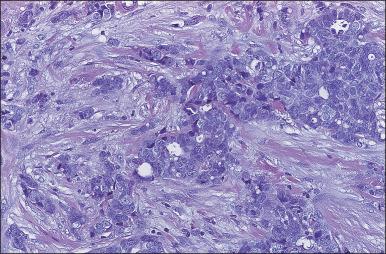
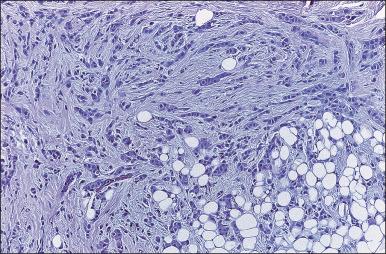
There are a number of less common types of breast carcinoma, including mucinous, tubular, and papillary, which are generally hormone receptor positive. Tubular cancers often resemble normal mammary ducts ( Fig. 88.4 ), whereas mucinous (colloid) carcinoma is characterized microscopically by abundant accumulation of extracellular mucin around tumor cells ( Fig. 88.5 ). In contrast, a frond-forming growth pattern characterizes papillary carcinoma ( Fig. 88.6 ). All three subtypes usually have a more favorable prognosis compared with hormone receptor–positive invasive ductal carcinomas of similar size and nodal status. In fact, according to the NCCN guidelines, adjuvant endocrine therapy is not strongly recommended for node-negative favorable-histology tumors measuring up to 3 centimeters in size, whereas treatment is recommended for invasive ductal or lobular carcinomas that are larger than 1 cm.
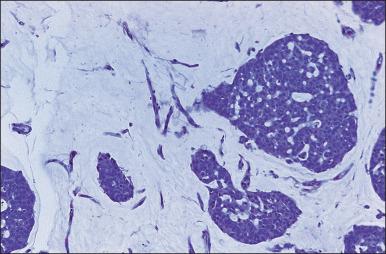
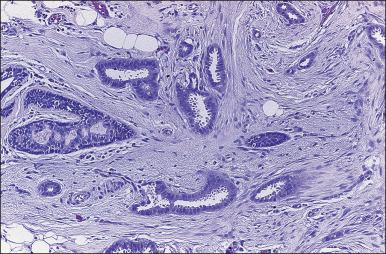

Although medullary carcinoma is typically ER, PR, and HER2 negative, which generally portends a poor prognosis, when it meets all the histologic criteria defined hereafter it too has a more favorable prognosis. The required histopathologic features include a well-circumscribed border, intense reaction with lymphocytes and plasma cells, poorly differentiated nuclei, a syncytial growth pattern, and little or no intraductal carcinoma ( Fig. 88.7 ). On the other hand, atypical medullary tumors, which do not meet all of these criteria, do not have the same excellent outcome, and care must be taken to avoid an incorrect diagnosis.
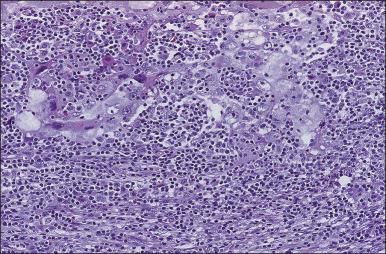
Adenoid cystic carcinoma and apocrine carcinoma are other rare subtypes that are typically ER, PR, and HER2 negative. In addition, apocrine carcinomas often express androgen receptor. Despite these characteristics, these tumors also typically have more indolent behavior. In contrast, some uncommon histologic types are associated with a poor prognosis and poor response to standard treatment. For example, metaplastic carcinomas generally have differentiation of neoplastic epithelial cells into other phenotypes, including squamous, spindle cell, or mesenchymal. Although they are less likely to have nodal involvement at the time of diagnosis, relapse rates are high.
BRCA1- and BRCA2- associated tumors have typical pathologic features. BRCA1 -associated breast cancers are usually of the basal-like subtype and are more likely to be negative for hormone receptors and HER2 overexpression. Conversely, BRCA2- associated breast cancers have more variable pathologic features and are often phenotypically similar to sporadic cancers, with a predominance of hormone receptor–positive tumors. Once cancer has been diagnosed, standard therapy is dictated by similar prognostic and predictive features to sporadic breast cancer, and no specific regimens are indicated on the basis of genetic predisposition at this time. The involvement of BRCA proteins in DNA repair by homologous recombination suggests that these tumors would be particularly sensitive to chemotherapies that induce DNA interstrand cross-links such as platinum salts, and there are clinical data supportive of this hypothesis. Furthermore, data suggest that BRCA -associated breast cancers may have higher 21-gene recurrence scores (RSs), potentially consistent with chemosensitivity of these tumors. Finally, poly (ADP-ribose) polymerase 1 (PARP1) is involved in the base excision repair pathway; when this repair pathway is pharmacologically inhibited in the setting of BRCA deficiency, synthetic lethality may result in cytotoxicity. The sensitivity of BRCA -associated ovarian cancer to the PARP inhibitor olaparib is demonstrative of this principle ; studies in BRCA- associated breast cancer have not yet demonstrated the same magnitude or consistency of response to date.
Much evidence supports the view that the development of malignancy is a multistep process and that invasive breast cancer has a preinvasive phase. During the carcinoma in situ (CIS) phase, normal epithelial cells undergo enough genetic alterations to result in malignant transformation. Transformed epithelial cells proliferate and pile up within lobules or ducts but lack the additional required genetic alteration that enables cells to penetrate the investing basement membrane. Two types of noninvasive breast cancers have been described: lobular carcinoma in situ (LCIS) and ductal carcinoma in situ (DCIS).
The original description of LCIS characterized the lesion as a lobular unit with a cluster of ductules or acini filled, distorted, and distended by proliferating epithelial cells ( Fig. 88.8 ). LCIS cells have a fairly uniform pattern of clear cytoplasm containing rounded, bland nuclei. Intercellular spaces are preserved, and clear vacuoles within the cytoplasm may displace the nucleus. This often is referred to as classic LCIS. In contrast, pleomorphic LCIS is a morphologic variant that is more aggressive. Pleomorphic LCIS elicits a similar pattern of infiltrative growth as invasive lobular carcinoma, yet neoplastic cells have marked nuclear atypia and pleomorphism.
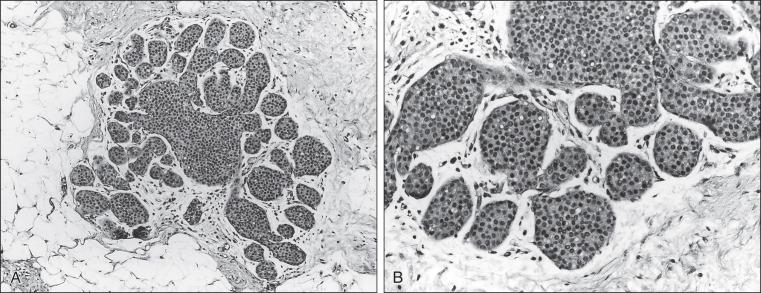
The terminal ductal lobular unit has been proposed as the site of origin of most breast cancer, including DCIS ( Fig. 88.9 ). In contrast to LCIS, which tends to be multicentric, DCIS is generally confined to one branching ductal system in the breast. DCIS, by definition, has intact basement membrane on light microscopy. Unlike pure DCIS, when microinvasion is present, type IV collagen and lamina are lost from the basement membrane in association with loss of membrane continuity. Such observations lend weight to the argument that DCIS is a precursor of invasive ductal cancer. Not all cases of DCIS progress to invasive cancer. Identifying the predictors of this process is a major challenge in understanding the biology of this disease.
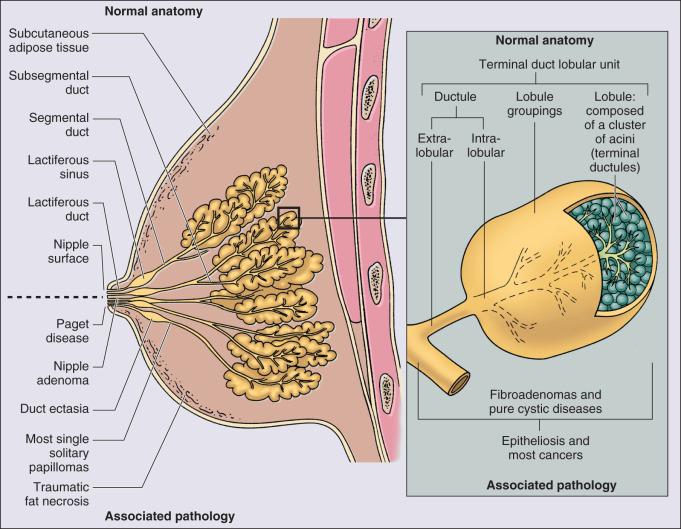
The pathologic classification of DCIS previously was based primarily on the architectural patterns of DCIS as seen microscopically, including solid, cribriform ( Fig. 88.10 ), comedo, micropapillary, and papillary variants. The features of DCIS that are currently routinely used to classify lesions as low or high risk for clinical care include nuclear grade, size, presence of comedo or necrosis, and, to a lesser extent, the architectural patterns.
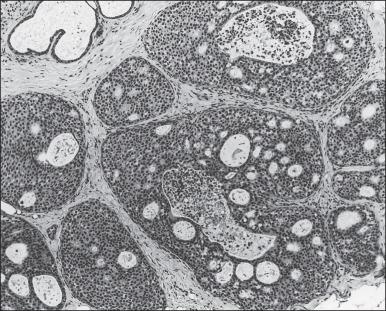
Estrogen plays a key role in the development of both normal breast epithelium and breast cancer, and the modulation of estrogen concentrations and ER signaling are key therapeutic modalities for the majority of breast cancers. Estrogens interact with mammary epithelial cells via specific ERs that function as nuclear transcription factors. The two known receptors, ERα and ERβ, are encoded by different genes and share an overall sequence homology of approximately 30%, although the homology is higher in the DNA- and hormone-binding regions. ERα is the receptor most closely associated with breast cancer; it is expressed mainly in the breast, uterus, and ovary. ERβ is more widely expressed, and its relationship to breast cancer is less clear. Binding of estrogen to the receptor results in a conformational change, displacement of heat shock proteins, and homodimerization. This homodimer then binds to the estrogen-responsive elements of the target genes and recruits coactivators or corepressors that further influence transcription. This participation in a multimeric signaling process likely contributes to the differential biologic effects that estrogen and estrogen-related compounds such as the selective estrogen receptor modulator (SERM) tamoxifen can have in different target organs. ER also has a minor ligand-independent transcriptional activating function, which is modified by phosphorylation and can facilitate “cross talk” between ER activity and receptor tyrosine kinase (RTK) signal transduction pathways. Approximately 70% of breast cancers express ERα (i.e., they are ER positive); these tumors tend to grow more slowly and appear better differentiated than ER-negative tumors. Moreover, antiestrogen therapy is effective in preventing development of breast cancer, reducing the likelihood of recurrence in the adjuvant setting, and prolonging survival once metastases have developed.
PR, itself encoded by an estrogen-regulated gene, gives rise to two distinct isoforms, PRA and PRB, by alternative splicing. PRB appears to be more specific to breast cancer. Interesting to note, a polymorphism in the PR promoter (+331 G/A) that increases transcription of PRB is associated with an elevated risk of endometrial and breast cancer. PR is variably expressed in ER-positive tumors, and this variability has prognostic relevance. ER-positive/PR-negative tumors occur more commonly in women older than 50 years, tend to be more aneuploid, and present as larger tumors with more frequent nodal involvement than ER- and PR-positive tumors. Furthermore, ER- and PR-positive tumors may be more likely to respond to antiestrogen therapy than ER-positive/PR-negative tumors, although more recent data suggest this likely reflects the better prognosis of the dual positive tumors as opposed to increased responsiveness to tamoxifen.
Human epidermal growth factor receptor 2 (HER2) is overexpressed in approximately 20% of breast cancers as a result of amplification of the HER2/ neu gene on chromosome 17q. HER2 functions as a transmembrane RTK, activated on dimerization with another member of the epidermal growth factor family of receptors, including EGFR (ERBB1), ERBB3 (HER3), and ERBB4 (HER4). The dimerization domain of a partner receptor, such as EGFR or HER3, is exposed on binding of a ligand such as heregulin or, alternatively, through ligand-independent mechanisms. Of note, HER2 itself does not have ligand-binding capacity. The HER2-HER3 heterodimer is the most potent of these dimer pairs, based on strength of interaction and downstream signaling. The oncogenic effects of this dimer pair are predominantly exerted through activation of intracellular signaling through the phosphatidylinositol 3-kinase (PI3K)-Akt-mTOR pathway, which in turn promotes proliferation and cell survival. In contrast to EGFR, in which amplifications in lung cancers frequently harbor activating mutations in the kinase domain, such activating mutations have not been found frequently in HER2 in breast cancer according to the Sanger Centre's COSMIC database, and HER2 oncogenic activity is exerted primarily through amplification.
Clinically, breast cancers marked by HER2 amplification have a more aggressive clinical course and decreased survival as compared with HER2-nonamplified tumors. HER2-amplified tumors can be associated with intracranial metastases. The identification of HER2 as an oncogene in breast cancer facilitated the development of therapies directed against it. The development and incorporation of HER2-targeted therapies into the adjuvant and metastatic settings have altered the natural history of HER2-amplified breast cancer dramatically. Trastuzumab is a HER2-targeted humanized monoclonal antibody that forms the cornerstone of HER2 targeted treatment, with proposed mechanisms of action including downregulation of HER2 dimerization and growth factor signaling cascades and induction of antibody-dependent cytotoxicity. Trastuzumab and other anti-HER2–directed therapies for treatment of both early-stage and metastatic breast cancer are described in more detail later.
Although the advent of HER2-targeted therapy has dramatically improved survival for patients with HER2-amplified breast cancer, de novo and acquired resistance to these treatments contributes to mortality. Studies aimed at elucidating mechanisms of resistance are providing further insight into the pathophysiology of HER2-positive breast cancer; two proteins, HER3 and PI3K, have emerged as key mediators of this resistance, including mutational activation of the latter. HER3 can promote oncogenic PI3K signaling, even in the presence of HER2 inhibition with trastuzumab. Furthermore, the CLEOPATRA phase III trial demonstrated that patients whose tumors harbored somatic activating mutations in the PIK3CA gene had shorter survival than those with wild-type disease. Data in the preoperative systemic therapy setting similarly identified an association between PIK3CA mutations and decreased pathologic complete response (pCR). However, these findings, while intriguing, do not yet have sufficient clinical usefulness to affect selection of therapy for individual patients. Increased levels of insulin-like growth factor–1 receptor (IGF1R) may bypass HER2 blockade by trastuzumab and allow growth factor activation of AKT, and a similar outcome may result from PTEN loss.
In addition to alterations that may circumvent HER2 signaling, changes in HER2 itself or effects of genes located nearby on chromosome 17 may also influence response to therapy. A truncated form of the HER2 protein itself that lacks the extracellular domain but retains the kinase activity has been described to correlate with trastuzumab resistance. Activating mutations in the HER2 gene in non-HER2-amplified breast cancer have been identified that may confer sensitivity to anti-HER2 directed therapy. Finally, the amplicon containing HER2 frequently contains additional genes that influence therapeutic efficacy. Although initially it was thought that HER2-positive disease is more sensitive to anthracyclines, recent data suggest that this sensitivity is conferred by the topoisomerase II gene ( TOP2A ) when it is present in the amplicon. Other cellular mechanisms of anti-HER2 therapy resistance are under investigation.
The PI3K pathway includes the PI3K holoenzyme and the downstream effector kinases AKT and mTOR; this pathway is critical for cancer cell growth, proliferation, and survival. This pathway is aberrantly activated through various mechanisms including activation of upstream RTKs including HER2, as described earlier, and activating mutations in pathway components such as PIK3CA kinase domain mutations and loss of functional regulatory components such as PTEN . Activating mutations in the PI3K catalytic subunit are common in breast cancer, particularly in ER-positive, HER2-nonamplified tumors, with an incidence in these tumors of approximately 30% to 40%.
PI3K pathway signaling is initiated by membrane-bound RTKs that undergo activation, for example, by dimerization. These activated RTKs bind to the regulatory subunit of PI3K, p85. This binding relieves inhibitory interactions and allows activation of the kinase subunit of PI3K, called p110, which is encoded for by the PIK3CA gene. Activated PI3K phosphorylates PIP2 to the second messenger PIP3, which then ultimately results in activation of AKT and mTOR. Ultimately, cell survival and proliferation result. The tumor suppressor phosphatase and tensin homolog (PTEN) counteracts PI3K activity by dephosphorylating PIP3 to PIP2.
Germline PTEN mutations cause a hereditary cancer predisposition syndrome known as Cowden syndrome, characterized by a high incidence of breast, uterine, thyroid, and skin neoplasms. PTEN is inactivated in a wide variety of human tumors as a result of either mutation or, more commonly, epigenetic silencing through methylation, including in breast cancer. PTEN loss is associated with genetic instability, and primary breast tumors that lack PTEN have increased aneuploidy. In addition, PTEN loss has been associated with a decreased likelihood of response to anti-HER2 therapy with trastuzumab. Data elucidating the relationship between presence of PIK3CA mutations and PTEN status show that they are inversely correlated.
The observed frequency of PI3K activation in breast cancer has led to clinical investigation of inhibitors of PI3K in the context of hormone receptor–positive and HER2-amplified disease (NCT02167854). These agents have demonstrated some efficacy but are also associated with substantial toxicity including rash, diarrhea, hyperglycemia, and depression. Their role in breast cancer remains to be elucidated.
The tumor suppressor TP53 (p53), also termed the “guardian of the genome,” is the most frequently mutated gene in human cancer. It plays a central role in sensing genotoxic and nongenotoxic stresses and transducing an antiproliferative effect (cell cycle arrest or apoptosis) in response. It is activated and regulated by posttranslational modifications to the N-terminal region, including phosphorylation and ubiquitination. In addition, by binding as a tetramer to specific DNA sequences via a central DNA-binding core region, it exerts its primary biologic function by modulating the transcription of dozens of genes. In transgenic mice, loss of p53 is associated with multiple spontaneous tumors, although not of the mammary glands. However, p53 loss accelerates the appearance of mammary tumors in murine mammary tissue that also overexpresses MYC, HER2, IGF1, and/or WNT1. These genetic studies are consistent with a role for p53 loss late in tumor development. Indeed, the transgenic restoration of p53 function leads to tumor regressions.
Mutant p53 accumulates in the nucleus of neoplastic cells. Thus initial studies that described only a weak association between aberrant p53 and adverse prognosis in breast cancer relied on immunohistochemistry (IHC) detection; more recent analyses based on mutation detection have confirmed a strong association. Mutations in exons 5 through 8 are more common in ductal and medullary tumors, tumors with an aggressive phenotype (high grade, large size, node-positive cases, and low hormone receptor content), and in women younger than 60 years. Furthermore, the presence of a mutation conferred an overall 2.27-fold increased RR of breast cancer–specific mortality, independent of other known prognostic markers (e.g., tumor size, node status, and estrogen receptor and PR expression). Finally, although not all mutations confer the same biologic properties (e.g., missense versus nonmissense), all have similar prognostic usefulness.
Breast cancers in individuals with germline p53 mutations are frequently ER and HER2 positive. Adjuvant radiation therapy is generally avoided in breast cancer patients with Li-Fraumeni syndrome owing to the risk of radiation-induced sarcomas ; mastectomy, often bilateral mastectomy, is more common. As noted earlier, many tumors harbor sporadic p53 mutations; p53 is an obvious target for cancer therapy, despite the apparent intractability of a loss-of-function genotype. Multiple approaches are being studied to overcome this limitation, including small molecules to restore p53 function or inhibit its interaction with MDM2, and adenoviral-mediated gene delivery. There are now multiple compounds in clinical trials, although no results are yet available in breast cancer.
The elucidation of genetic aberrations in cancer genomes, including mutations, deletions, and amplifications, has led to a better understanding of cancer pathophysiology. In addition, this knowledge is assisting with rational drug development by identifying potential targets. With the determination of the DNA sequence of the normal human genome, efforts have shifted toward a more comprehensive analysis of cancer genomes. The first report of a comprehensive sequence analysis of 21,000 of the best studied and annotated human genes was published that included data from 11 breast cancer samples. This screen rediscovered cancer genes known to be associated with breast cancer (e.g., p53 and BRCA1 ) in addition to genes not previously characterized as associated with cancer. An individual breast cancer was shown to harbor an average of about 90 mutant genes, although only a minority are likely to be driver mutations. In addition, although the functionally important mutations often differed among tumors, when the genes were analyzed in functional groups, mutations in signal transduction pathway and transcription factor genes were found in nearly all breast tumor samples. As detailed subsequently, rapid advancements in sequencing technology and bioinformatics have since greatly expanded the information available.
Genome-wide RNA transcriptional profiling in combination with novel bioinformatic approaches has led to the development of molecular classifications based on gene signatures comprising the quantitative expression of thousands of genes. Tumors can be classified either according to transcripts that tend to segregate together according to underlying biologic differences (unsupervised clustering) or sorted according to a given end point such as prognosis or response to therapy (supervised clustering).
Initial studies with array-based expression profiling showed the ability of the technology to classify breast cancer according to five gene clusters: luminal subtype A, luminal subtype B, HER2-positive, basal, and normal breast–like subtypes ( Fig. 88.11 ). The ER-positive group was characterized by high expression of many genes expressed by breast luminal cells, and the ER-negative group showed gene expression characteristic of basal epithelial cells. However, a third group showed genes related to HER2 overexpression, suggesting that this molecular characteristic may have equal or greater weight than ER expression in subclassifying breast cancers. Finally, the normal breast-like group of breast cancers clustered with normal breast epithelium. These distinct subtypes of breast tumors show distinctive molecular signatures and appear to represent diverse biologic entities associated with distinct clinical outcomes, and the comparison of several independently developed gene signatures appears to show similar prognostic information, suggesting the existence of a common set of biologic phenotypes. Luminal A–type cancers have the most favorable long-term survival, whereas HER2-positive and basal-like cancers may be more sensitive to chemotherapy but have the worst overall prognosis. These patterns of gene expression appear to provide more specific information than identification of a single gene with a specific effect. Thus breast cancer is not a single disease with heterogeneous ER and HER2 expression but appears to comprise three to five molecularly and clinically distinct subtypes.
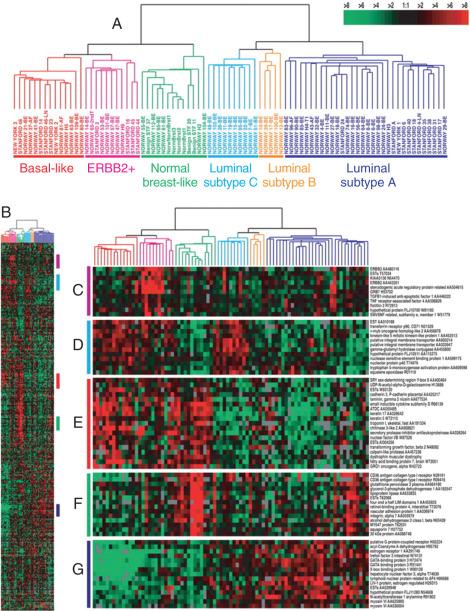
A similar approach can be taken by examining DNA copy number abnormalities, including amplifications and deletions, across the genome. Mapping these abnormalities against both the biologic subtypes described earlier and clinical outcome data demonstrates the potential to identify high-level DNA amplification that, similar to HER2, may be useful in identifying therapeutic targets. Emerging knowledge now aims to integrate patterns of gene expression, methylation, copy number variation, and mutation. This approach, using The Cancer Genome Atlas (TCGA) Network, holds significant potential but will require independent validation using data sets that include treatment and outcome.
In the meantime, although these classifications are robust across a population, they have not yet been shown to be clinically applicable for individual treatment decision making. Furthermore, because much of the molecular heterogeneity overlaps with conventional histopathology and is captured by determination of ER, PR, and HER2 status and tumor grade, use of these molecular tools adds little to current standard pathologic information.
More recently, more comprehensive approaches have been undertaken to examine the molecular profiles of breast cancer. A comprehensive and integrated analysis of 825 primary breast cancers using genomic DNA copy number arrays, DNA methylation, exome sequencing, messenger RNA arrays, microRNA sequencing, and reverse-phase protein arrays was conducted by TCGA and confirmed the existence of four main subtypes of breast cancer. In addition, it provided a wealth of data regarding genetic and epigenetic information for potential therapeutic targeting. Complementary to TCGA, the ENCODE project (Encyclopedia of DNA Elements) mapped regions in non–protein-coding DNA of transcription factor association, transcription, chromatin structure, and histone modification with the goal of determining biochemical functions for many areas of the genome, including those mutated in cancer. As technology advances and becomes more inexpensive, even more comprehensive analysis of breast cancer genomes will likely continue to increase our understanding of both breast cancer and how to use the information for both treatment and prevention.
Cancer cells have two somewhat contradictory traits. Although they originate from a single clone, they often display marked genetic, biologic, and morphologic heterogeneity. Historically, the prevailing hypothesis was that genomic instability contributed to continuing tumor evolution and emergence of different and ultimately more virulent subclones, leading to disease progression and resistance to therapy. More recently, an alternative explanation was provided by groundbreaking work elucidating the “cancer stem cell” model ( Fig. 88.12 ). Initially demonstrated in hematologic reconstitution and malignancies, cancer stem cells, although constituting only a small minority of the tumor mass, retain the capacity for self-renewal and differentiation. Differentiated cells, although forming the bulk of the tumor, are themselves incapable of endless replication. Given that stem cells are long-lived and slow to replicate, this would explain both the accumulation of genetic mutations over time and the resistance to therapy targeting dividing cells. It would also explain the frequently observed concordance between primary and metastatic cells.
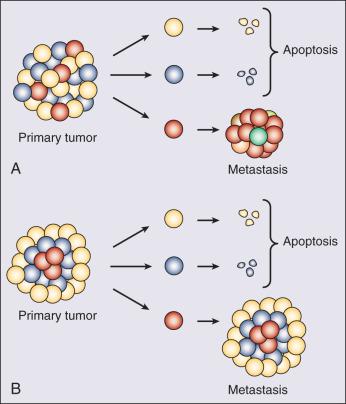
For a long time this model for epithelial cancers has been theoretical, because it was technically difficult to identify these cells. However, such cells have been isolated from both normal mammary glands and breast cancers, based on the presence and absence of specific surface markers. The ability to reconstitute human breast cancers in immunocompromised mice seems to reside within a minority CD44 + , CD24 −/low subclone. Notably, tumors formed by these cells gave rise to mixed populations of epithelial cells recapitulating the morphologic characteristics of the parent tumor. These findings have several important implications for breast cancer therapy. As a first step, the molecular and biochemical pathways that control cancer stem cell division (such as Wnt and Notch pathways) might provide novel targets for therapy. A phase I trial of a Notch-targeting γ-secretase inhibitor in combination with cytotoxic chemotherapy in breast cancer identified preliminary evidence of efficacy. Additional trials of drugs targeting the Notch pathway and others involved in cancer stem cells are underway.
More than 90% of patients diagnosed with breast cancer have no evidence of disease outside of the breast and ipsilateral axillary lymph nodes. However, approximately 30% of patients with primary operable breast cancer have disseminated tumor cells (DTCs) that can be detected in bone marrow at the time of diagnosis. In a follow-up study, 15.5% of patients had detectable DTCs 3 years after diagnosis, a finding that was associated with increased risk of relapse and death. Despite these data, however, assessment of DTCs has not been incorporated into routine practice, in part because of the need for a relatively invasive procedure.
Tumor markers are proteins, such as those derived from MUC1 (e.g., CA15-3, CA27.29) and carcinoembryonic antigen, that are shed from tumors and identified in the circulation. However, their usefulness is limited to monitoring of response to therapy or progression of disease. More recently there have been considerable methodologic advances in the assessment of circulating cancer biomarkers, including circulating tumor cells (CTC) and circulating nucleic acids, which may play a role in diagnosis, monitoring, and treatment of disease.
It is possible to measure CTCs using an automated immunobead enrichment followed by pancytokeratin staining. With this approach, presence of five or more CTCs per 7.5 mL of blood is prognostic, with significantly worse overall survival (OS; 8.2 months versus 18 months) compared with those patients with fewer CTCs. The clinical usefulness of CTCs for treatment decision making in metastatic breast cancer was prospectively tested in a randomized phase III trial; however, use of the assay was not shown to result in improved disease outcomes and therefore it is unclear how best to incorporate it into routine clinical care. The immunobead method lacks sensitivity owing to the use of epithelial cell adhesion molecule (EpCAM)–based detection, because less differentiated cells often lack EpCAM expression and will avoid detection, so newer methodologies including isolation of CTCs based on size or other properties are being developed. Furthermore, the ability to isolate CTCs permits single-cell analysis, including assessment of molecular markers such as ER expression and HER2 amplification in real time.
Technologic advances have also resulted in the ability to detect nucleic acids, including circulating tumor DNA (ctDNA) and microRNA (miRNA), that are shed from dying tumor cells into the blood and may be more sensitive and specific than standard biomarkers. Because analysis of circulating nucleic acids has the potential to identify emerging mutations that could lead to altered treatment options, their use has potential to improve disease outcomes. ctDNA and can be specifically identified by the presence of tumor-specific mutations, including in more than 90% of patients with metastatic breast cancer. Serial assessment of ctDNA via detection of these mutations may be useful for monitoring of patients for disease recurrence or progression ; relative levels have been shown to correlate with tumor burden. Similar findings have been demonstrated with miRNAs.
More recently, it has become apparent that in addition to detection of cancer, assessment of circulating biomarkers may be useful for monitoring changes in tumors that could affect treatment. For example, multiple groups have identified activating mutations in the ligand-binding domain of ESR1, the gene that encodes ERα, which are present in up to 30% of endocrine therapy–resistant patients but which are only rarely detected in primary tumor specimens. Studies have also demonstrated the use of massively parallel sequencing of ctDNA for examining intratumor heterogeneity, which could also potentially be used to identify targetable mutations. Companies are now capitalizing on the new technology and providing assays for monitoring patients, although the clinical usefulness of these commercial assays is currently still in question. As the sensitivity of detection of these circulating biomarkers improves with advances in technology, it is likely that liquid biopsies will become routinely used for monitoring patients with metastatic breast cancer. However, use of this technology for diagnosis or detection of disease recurrence remains questionable.
An individual can be deemed at high risk for breast cancer based on a calculation from a breast cancer risk assessment model, a genetic test result, or other family or personal history considerations that result in an estimation of an individual's lifetime risk of breast cancer that is above population risk. There is no universally accepted definition of “high risk.” Whatever criteria an individual physician and patient use to define high risk, four possible actions may be taken, some of which can be used simultaneously: (1) enhanced surveillance; (2) behavioral modification; (3) chemopreventive strategies; and (4) prophylactic mastectomy and/or oophorectomy.
As discussed in the section on mammographic screening, there is significant debate about the age at which to begin mammographic screening in average-risk women. Nonetheless, ample evidence supports increased surveillance in women at high risk for breast cancer, and strategies are being developed. Carriers of germline BRCA mutations, for example, may begin mammographic surveillance at age 30. The American Cancer Society (ACS) and the American College of Radiology (ACR) appropriateness criteria recommend consideration of annual breast magnetic resonance imaging (MRI) in addition to mammography for individuals who have a 20% or greater lifetime risk of breast cancer, including those with germline BRCA mutations, those who have a family history suggestive of a familial risk of breast cancer but in whom genetic testing has not been performed, those with a history of atypia, and those with a personal history of breast cancer or chest irradiation between ages 10 and 30. The timing of such imaging is not evidence based. Some providers recommend alternating mammography and MRI every 6 months, whereas others recommend annual simultaneous imaging for convenience. Recommendations regarding age at which breast surveillance should be initiated may be individualized based on earliest age of onset of breast cancer in the family. In addition, other genetic mutations and syndromes also increase the risk for breast cancer and require initiation of screening at an earlier age according to both the ACS and NCCN guidelines, although the recommended age of initiation of screening MRI varies by gene.
Finally, although controversy remains about the role of breast self-examination in the general population, experts in the surveillance of high-risk women still recommend breast awareness for women with BRCA mutations in addition to clinical breast examinations. For males with pathogenic germline mutations, it is important to recognize that the absolute risk of breast cancer remains relatively low (≤10%) and that evidence for screening with use of any modality is limited.
Multidisciplinary centers that provide counseling for women who are at substantial risk for breast cancer are well established throughout the United States. These multidisciplinary consultations provide recommendations for a range of surveillance and interventional approaches. In addition to the available surgical and medical preventive strategies, modification of lifestyle factors, such as diet, alcohol consumption, and exercise, may be discussed. At this time, behavioral modifications do not have demonstrated efficacy as primary prevention for breast cancer in high-risk individuals.
A significant 49% reduction in risk of invasive breast cancer with tamoxifen compared with placebo was seen in the National Surgical Adjuvant Breast and Bowel Project (NSABP) P-1 study ; similar findings were noted in the International Breast Cancer Intervention Study (IBIS-I). Subsequently, two SERMs, tamoxifen and raloxifene, were directly compared in the NSABP STAR trial; long-term follow-up demonstrated that although raloxifene was less toxic than tamoxifen, it was slightly less effective in decreasing invasive breast cancer. Based on these findings, multiple groups have recommended that SERMs be considered to reduce the risk of breast cancer in women with a 5-year projected risk of developing breast cancer of 1.66% or greater. More recently, the aromatase inhibitors (AIs) exemestane and anastrozole have been shown to decrease the risk of invasive breast cancer in the randomized placebo-controlled, double-blind MAP.3 and IBIS-II clinical trials, respectively. Longer follow-up is required to confirm these data, including possible long-term side effects of the medications.
Tamoxifen has been shown to reduce the risk of contralateral breast cancer by 50% to 60% in BRCA1 and BRCA2 carriers, respectively, even though BRCA1 -associated cancers are generally ER negative. However, two European chemoprevention studies performed at the Royal Marsden Hospital and by the Italian Tamoxifen Prevention Study Group, respectively, did not show a decrease in the incidence of breast cancer in women from high-risk families when tamoxifen was used.
For all of these agents, it is not known whether they reduce the incidence of breast cancer by preventing the formation of cancer or by treating small, clinically occult cancers. In practice, the potential chemopreventive benefits of these agents, along with consideration of an individual's baseline risk, must be balanced in the context of their known toxicity profiles. Indeed, patients and providers alike are often cautious about chemoprevention in light of potential adverse events.
Prophylactic mastectomy is associated with a reduction in breast cancer risk of approximately 90%, which is a substantial absolute reduction in patients with either a strong family history of breast and/or ovarian cancer or a genetic predisposition to breast cancer. Additional data show that contralateral prophylactic mastectomy (CPM) can reduce the risk of breast cancer in patients with a previous diagnosis of unilateral disease. A high prevalence of premalignant lesions, including atypical hyperplasia, is seen in prophylactically removed breasts from women who are at hereditary risk for breast cancer.
Statistical analysis has shown that, depending on the assumed penetrance of the BRCA mutation, compared with surveillance alone, 30-year-old patients with early-stage breast cancer who have BRCA mutations may gain 2.9 to 5.3 years from prophylactic bilateral mastectomy and 0.6 to 2.1 years from CPM. A survival analysis suggested that prophylactic mastectomy at age 25 years and oophorectomy at age 40 years maximized survival at 70 years of age; it is important to note, however, that substituting enhanced breast cancer screening (with MRI and mammography) for mastectomy resulted in similar survival. The gain in quality of life in these high-risk women who chose to undergo prophylactic mastectomy is controversial. Given the impact on quality of life, the potential medical repercussions of an operation, including the reconstruction that sometimes follows, and the presence of an effective, alternate breast cancer risk mitigation strategy (enhanced surveillance), the choice of prophylactic mastectomy is personal and certainly not mandated by providers counseling high-risk women. However, if a patient opts for enhanced surveillance, the possibility of diagnosis of an early-stage breast cancer that may require systemic chemotherapy must be clearly discussed.
Although physicians caring for women at increased risk of breast cancer generally do not mandate prophylactic mastectomy, women at increased risk for ovarian cancer, for example because of germline mutations in BRCA1/2 , are strongly encouraged to undergo risk-reducing salpingo-oophorectomy. Unlike breast MRI and mammography, ovarian cancer screening with transvaginal ultrasound and CA125 measurement is not effective at diagnosing ovarian cancer early, and ovarian cancer is generally diagnosed at a stage when curative treatment options are limited. Furthermore, the benefits of risk-reducing oophorectomy in BRCA carriers are significant and include a reduction in breast and ovarian cancer risk, and reduced breast and ovarian cancer–specific mortality and all-cause mortality. Despite the limitations of ovarian cancer screening, for some women with BRCA mutations whose ovaries and fallopian tubes are intact, transvaginal ultrasonography and CA125 screening are recommended.
The age at which risk-reducing bilateral salpingo-oophorectomy is performed is not trivial, because the induction of early surgical menopause may have long-term systemic effects including those on bone health and cardiac function, in addition to significant effects on quality of life. The age at which surgery is recommended is based on the age-adjusted risks of ovarian cancer and is generally slightly earlier for BRCA1 carriers than BRCA2 carriers. A limited duration of HRT is safe in terms of breast cancer risk for premenopausal women with no personal history of breast cancer and with intact breasts, and may provide substantial benefits in terms of quality of life and overall health. It is generally recommended that these women stop HRT around the age of natural menopause. Important to note, BRCA carriers who undergo risk-reducing salpingo-oophorectomy remain at risk for developing primary peritoneal cancer, for which no screening or risk reduction strategies are delineated.
Become a Clinical Tree membership for Full access and enjoy Unlimited articles
If you are a member. Log in here